What to look for in an endurance road bike and our pick of the best
The best endurance road bikes will help you cover long distances and ride in comfort across a variety of terrain.
As a result, an endurance road bike is a great choice for riders who prefer a slightly more relaxed riding position than an out-and-out race bike.
Choosing the best road bike for your requirements needn’t be a compromise, however, and the latest endurance bikes are faster and more versatile than ever.
Many of the newest models feature aerodynamic frame details, clearance for wide tyres (often up to 35mm), road disc brakes and generous gearing for climbing, making endurance road bikes suitable for a wide range of riding.
Thanks to their focus on comfort and ability to cover great distances with relative ease, endurance road bikes are also referred to as sportive bikes.
If you’re new to cycling, a sportive is an ideal way to challenge yourself, ride new terrain and meet other riders. In exchange for your entry fee, you’ll get signposted routes, feed stations and facilities at the start and end of the ride.
Here are the best endurance road bikes reviewed by BikeRadar. Keep reading until the end for our full buyer’s guide and tips on what to look out for in an endurance bike.
Best endurance road bikes, as rated by our expert testers
Fairlight Strael 3.0
- £2,900 as tested
- Pros: Super-comfortable; very adaptable; neat dynamo integration
- Cons: Very little
Sprightly yet comfortable, the Fairlight Strael, now in its third generation, is designed as a four-season road bike. Fairlight makes the steel frame in both regular and tall variants, to suit different rider morphology, with each bike built to order so you can choose your own spec.
There's plenty of room for wide tyres - 36mm - and mudguards to get you through the worst of the weather. Endurance features include a third bottle cage mount.
We rated the ride quality as unobtrusive - the frame does a great job of smoothing the road, holds a line and climbs well and - as usual - we took in some bridleways on wider tyres, which were handled with ease.
BH RS1 5.0

- £5,799 / €5,999 as tested
- Pros: Aerodynamic but with endurance ride position; light for an aero bike
- Cons: Firm ride from the hardy tyres
The RS1 is an aero, integrated road bike. But rather than the race-targetted machine that this would usually indicate, it's an endurance bike with a higher stack for all-day riding. That's offset by deeper drops than found on most endurance bikes though, so you can get lower if you want an extra turn of speed.
In this spec, it's kitted out with a 52/36t Ultegra 12-speed groupset with 11-34t cassette and 40mm deep Vision carbon wheels with 28mm Hutchinson tyres.
The ride is firmer than on many endurance bikes and handling is racier as well. Unlike many endurance bikes, you don't get mudguard eyes, perhaps reflecting the weather in BH's Spanish home. But overall it's a great option for riders looking to ride fast as well as long.
BMC Roadmachine 01 Two

- $12,999 / €12,999 / AU$17,499 as tested
- Pros: Wonderfully balanced ride quality; 40mm tyre clearance; down tube storage; luxuriously comfortable cockpit
- Cons: Not the lightest; immense price; you'll want a dedicated gravel bike if you ride often on gravel
BMC's third-generation Roadmachine sports clearance for gravel-like 40mm tyre clearance, as well as integrated down tube storage and a frame that's claimed to be 27 per cent more compliant. Much of the boosted compliance comes down to the revised rear triangle, with the kinked seatstays. There's also an integrated 20-lumen rear light, which slides behind the seatpost.
This top-of-the-range build impressed in testing, with our tester bowled over by the superb ride quality. The front end matches the rear's comfort and the ICS Carbon Evo cockpit is luxuriously comfortable.
It's a sorted spec too, with a full Shimano Dura-Ace Di2 R9200 electronic groupset, paired with DT Swiss ERC 1100 Dicut wheels.
The only real fault to note, other than the astronomical price, is both the frame and fork are heavier than the second generation. But we appreciate BMC for focusing on compliance and stiffness.
Our tester also concluded if you ride frequently on gravel, you'd be better off investing in a specific gravel bike, feeling the geometry didn't translate fully to the rough stuff.
Cannondale Synapse Carbon LTD RLE
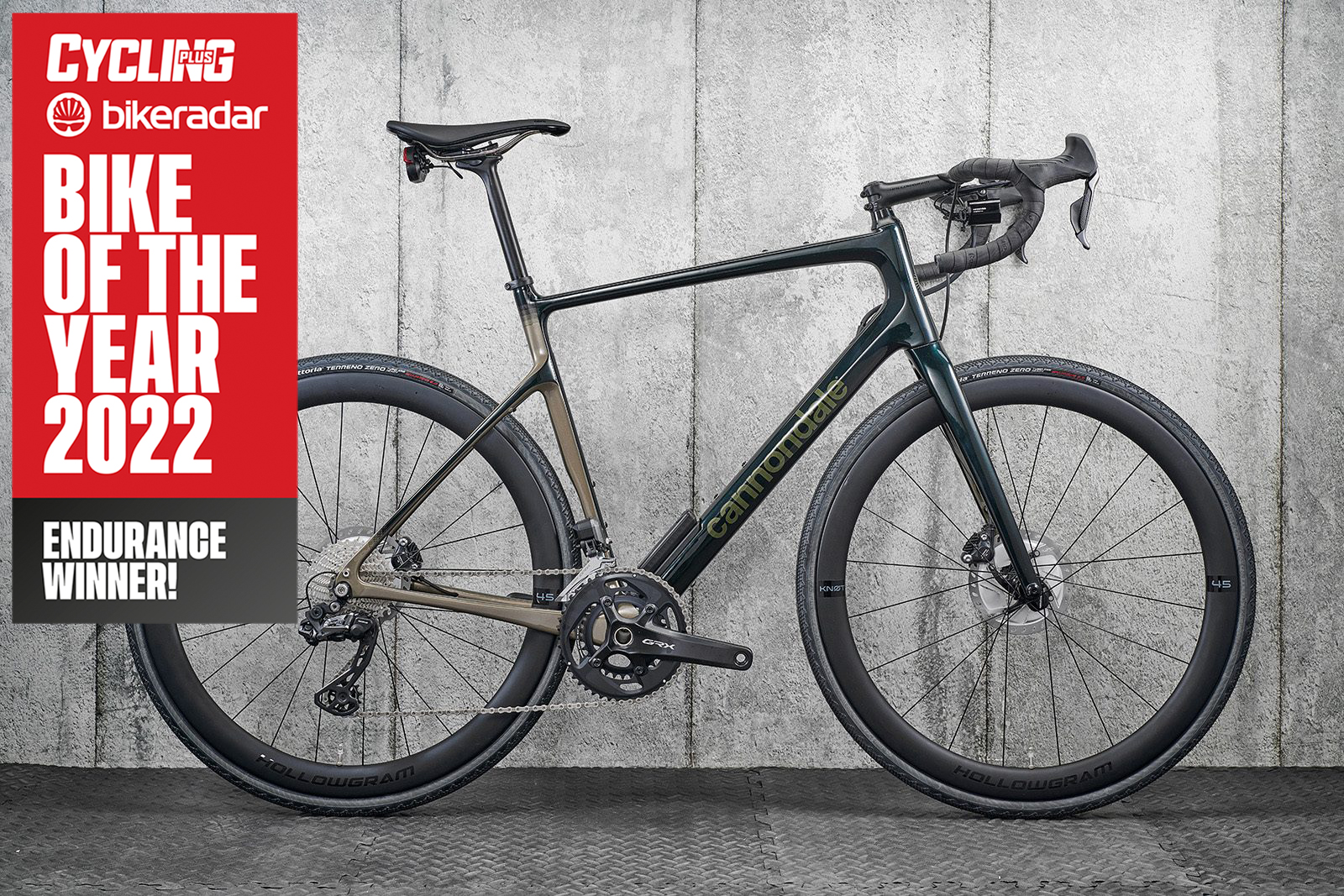
- £6,750 / $7,050 / €6,999 as tested
- Pros: Supple smoothness and exciting handling; 35mm tyre clearance and all-terrain ability
- Cons: Gravel tyres overkill if you don't venture off tarmac
Our 2022 Endurance Bike of the Year, the Synapse LTD RLE has Cannondale's SmartSense integrated central battery and lights, a smart wheel sensor and a Garmin Varia rear-view radar in the spec.
It's not just about the added safety features though. The Synapse is all that an endurance bike should be, with wide 35mm tyre clearance with room for mudguards and the same geometry as its cobbled-race-ready predecessors.
The Synapse comes with proportional tube profiles, for a consistent ride experience between sizes and there's a threaded bottom bracket to ease maintenance.
For anyone wanting to go really long, there's a third bottle mount and top tube bar mount, as found on the best gravel bikes.
In this spec, you get a Shimano Di2 GRX815 groupset and KNØT 45 wheels with Vittoria Terreno Zero 32c tyres, adding some all-terrain ability. Cannondale fits its aero HollowGram Save SystemBar.
The GRX gearing means that there's plenty of low range to tackle steep climbs, but we didn't miss the higher range that the 48-11t highest gear misses. The Synapse is comfortable, light and agile.
We've also reviewed the Cannondale Synapse Carbon 2 RL, a lower spec of the Synapse.
Canyon Endurace CFR eTap

- £8,999 / $8,999 / €9,499 / AU$14,349 as tested
- Pros: Rapid for an endurance bike; exceptional spec; superb ride quality
- Cons: No mudguard mounts and handlebar tape covers little of the tops
The Canyon Endurace CFR is the brand's top-flight endurance road bike made from its lightest grade of carbon.
Its high-end spec, including a full SRAM Red eTap AXS groupset and DT Swiss ERC 1100 wheels, rivals the kit on bikes worth £3,000/$3,000 more.
On the flat and climbs, the Endurace CFR feels nearly as fast as a race bike, but much more comfortable.
With clearance for 35mm tyres, light gravel is not out of the question. The lack of mudguard mounts is the Endurace CFR's only real fault.
Cube Attain GTC SL

- £2,499 as tested
- Pros: Good value; blend of race and endurance geometry; fair compliance
- Cons: Needs lighter wheels
The Cube Attain GTC SL offers an only slightly less refined ride experience than its five-star competitors.
The German brand's first foray away from race bikes into the endurance bike realm retains a degree of aggressive geometry, in its steep seat and head angle.
As a result, the handling is fairly lively on the flat and a hoot on descents.
The Ultegra R7000 groupset forms part of a decent-value spec, but the Cube would benefit on climbs from a lighter wheelset.
Giant Defy Advanced SL 0

- £11,499 / $12,000 / €11,999 / AU$13,999 as tested
- Pros: Light and smooth; superbike spec; sublime handling
- Cons: Press-fit bottom bracket may divide opinion
Giant's Defy is lighter, smoother and more aero than its predecessor, with a revised geometry to make it feel sportier. Significant weight savings have been made to the frameset, with the frame claimed to weigh a scant 785g in a size medium, a 195g saving over the outgoing Defy. The fork's weight has also been reduced to 350g from 403g.
There's a revised handlebar and seatpost too, both intended to take the sting out of rough roads.
Out on the road, the Defy has a class-leading smoothness and impeccable handling manners. The bike feels faster than before, more akin to an all-rounder race bike such as Giant's own TCR.
It wafts over rougher road textures, but there's plenty of stiffness to keep things balanced.
The spec is dreamy too, with a SRAM Red eTap AXS and carbon Cadex 36 wheels, the former really enhancing the bike's responsiveness to big efforts.
Liv Avail Advanced Pro 0

- £5,999 / $6,500 / €6,399 / AU$7,999
- Pros: Great handling and cornering; comfortable over longer distances; comprehensive spec
- Cons: Chunky bar tape makes the drops overly thick; press-fit bottom bracket may divide opinion
Now in its fifth generation, the Liv Avail Advanced Pro 0 is the top-tier offering in the brand's endurance road bike line-up. It's built for big days in the saddle but don't worry about sacrificing speed because this is one fast ride.
The Avail has a sleek silhouette, with an integrated front end and a proprietary D-shaped seatpost and handlebar, both of which are designed to enhance comfort. Tyre clearance is generous at 35mm (measured) and this particular model is kitted with a near-complete Shimano Ultegra Di2 R8100 groupset and mid-depth, own-brand carbon wheels.
Our tester threw everything at the Avail and found it to no longer be the sluggish cousin of the racier Langma and EnviLiv. It spurs you to give it everything you've got, while being wonderfully practical, with mudguard mounts, generously sized tyres and wide gearing.
The only real flaw is our tester found it hard to grip the shifters while in the drops because of the thick bar tape, meaning she struggled to wrap her hands around them safely. However, this is easily remedied.
Merida Scultura Endurance Rival Edition
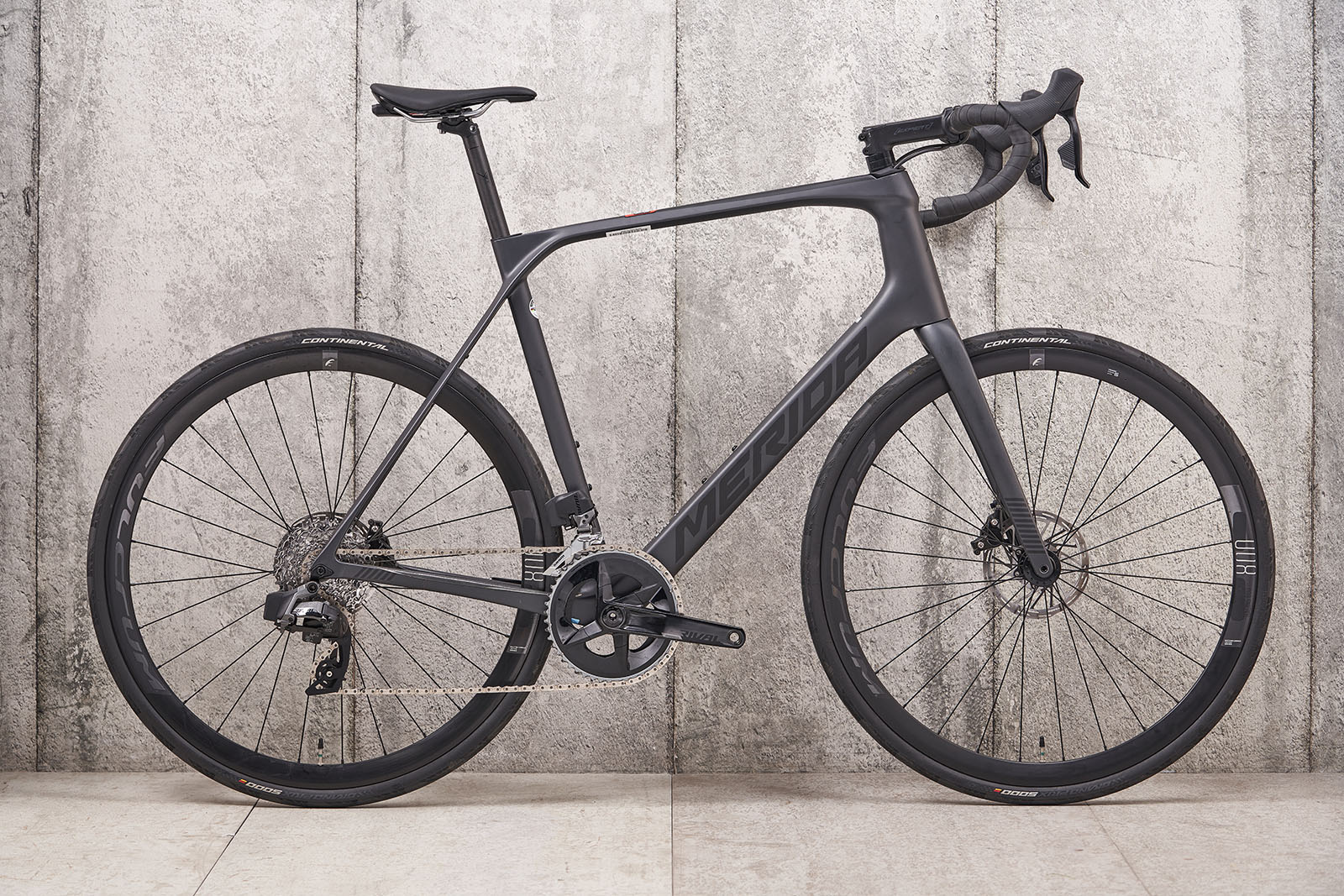
- £3,400 / €4,463 / AU$4,999 as tested
- Pros: Compliant ride; assured handling; good uphill
- Cons: Weighty wheels; skinny also bar and tape reduce front-end comfort
The Merida Scultura Endurance Rival Edition has a quality spec, aside from its sub-par wheels, at a competitive price.
Despite its heavy overall weight, the simply designed endurance road bike is far from sluggish and climbs well.
With mellow geometry and clearance for 35mm-wide tyres, the Scultura Endurance is comfortable on long road rides and has the potential to be confident off-road too, if you wish.
Scott Addict 30

- £2,349 / $3,300 / €2,599 / AU$4,900 as tested
- Pros: Poised ride; high-quality components; harmony between speed and comfort
- Cons: Long wheelbase; faster wheels and tyres would be nice
The Scott Addict 30 handles serenely and is amply comfortable for big days out on less than smooth surfaces.
However, look beyond its long wheelbase and you'll see elements of more aggressive geometry, such as a relatively long reach.
The Scott Addict 30's rigid carbon frame responds promptly to the power you exert through the Shimano 105 R7000 drivetrain. This makes all-out efforts rewarding and thrilling.
Simplon Kiaro Disc

- £4,406 / €4,529 as tested
- Pros: Neat cable integration; lightweight; well-specced
- Cons: Limited UK dealer network
The Kiaro Disc from Austrian brand Simplon has a frame designed to absorb bumpy surfaces and aero features such as full internal cable routing through the one-piece bar and stem.
The spec includes a mechanical Ultegra groupset and quality alloy DT Swiss ER1400 wheels. They’re tubeless-ready, as are the Schwalbe Pro One 28mm tyres.
The Kiaro Disc is light at 8kg for a size large, although a bit difficult to find in the UK, with a limited dealer network.
Basso Astra 105 Di2

- £3,799 / $4,644.99 / €4,195 / AU$6,709.99 as tested
- Pros: Ideal endurance geometry; lively handling; wide tyre clearance
- Cons: Rigid ride on rougher tarmac; could do with nicer tyres
Basso has relaxed the geometry of latest Basso Astra 105 Di2, making it more suitable for covering long distances, while the wider 35mm tyre clearance increases its versatility.
But the Italian brand hasn't dulled the experience of riding the Astra – its handling is nearly as fast as a race bike's.
You'll probably want to upgrade the alloy wheelset from Basso's in-house brand Microtech. The same goes for the stiff and sluggish Continental Ultra Sport tyres.
Bombtrack Audax
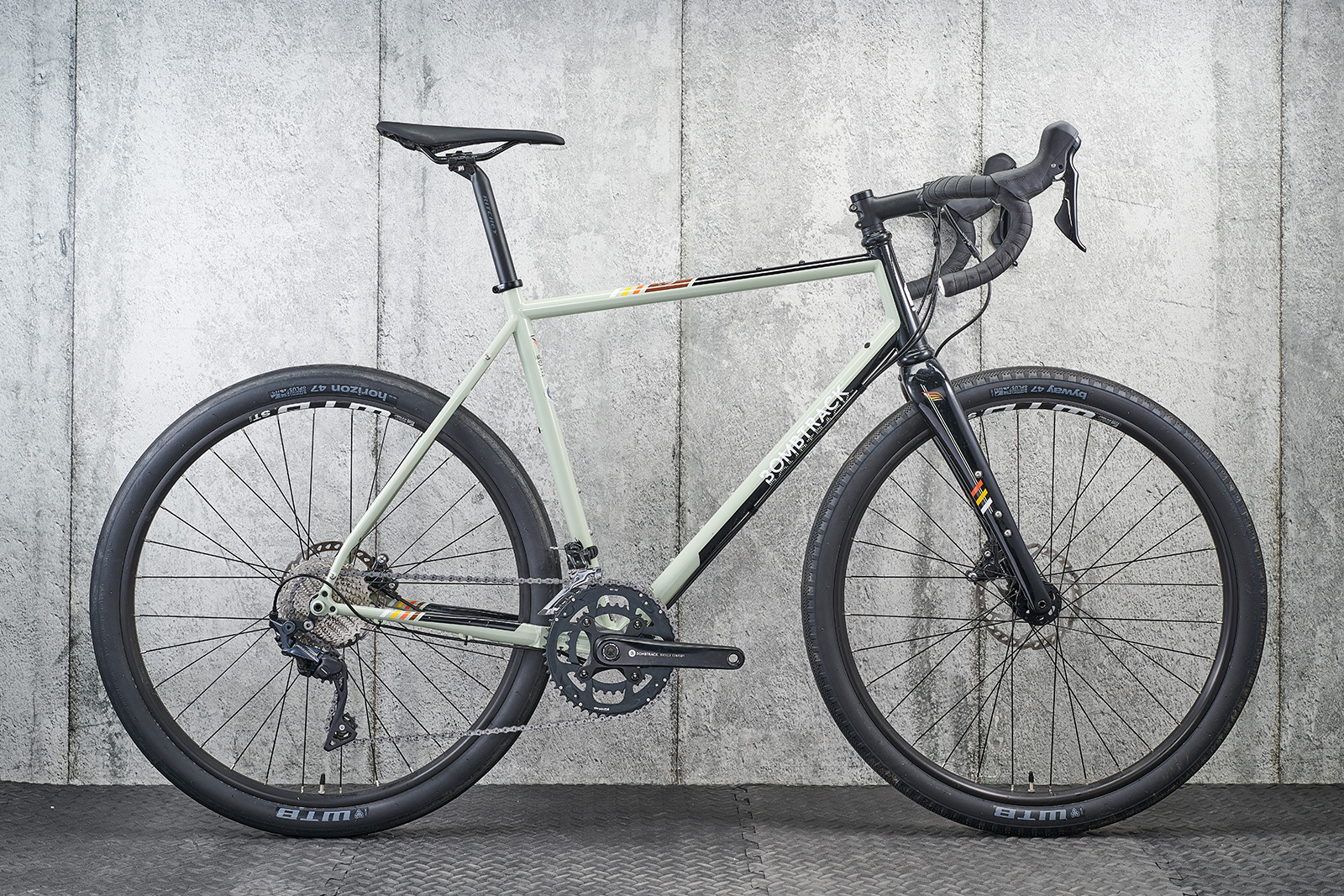
- £2,750 / $3,415 / €2,850 / AU$4,400 as tested
- Pros: Great downhill performance; comfortable ride; something different from the norm
- Cons: Not light; some may not appreciate its unconventional nature
A steel frame, big clearance and 650b wheels with 47mm tyres set the Bombtrack Audax apart from the usual run of endurance road bikes. Despite looking like a gravel bike, with the mounts to match, the Audax's geometry is thoroughly road-going with a sporty, rapid ride on tarmac. It's even faster on descents, thanks to the grip from the wide tyres.
The Audax is well specced for the endurance rider too, with comfortable Ritchey bars and a mixed Shimano 105/Ultegra RX drivetrain and a 48/32t Bombtrack chainset.
There's plenty of comfort thanks to the tyres too, with the bike wafting over poor surfaces – and yes, you can take it on gravel too. It's a great long-distance option.
Cannondale Synapse 1

- £1,900 / €1,995 as tested
- Pros: Comfortable ride with good contact points; lots of mounting points; excellent groupset and generous tyre clearance
- Cons: More expensive than rivals; non-series crankset; tyres aren't tubeless-ready
Cannondale's top-line aluminium Synapse is a fast-riding machine with a generous 32mm tyre clearance (with 6mm room on either side of the tyre), meaning it's versatile across a range of surfaces. There are mudguard mounts aplenty and the geometry is suitable for all-road riding.
You get a Shimano 105 R7020 groupset, with a deviation to the crankset in the form of Shimano's RS510. Reliable DT Swiss R470 rims are laced to Formula hubs, with the rims optimised for tyres between 28 and 35mm wide.
Our tester found the handling very predictable out on the road, with good acceleration and a great feeling of efficiency through the aluminium frame. The mudguard mounts mean the bike will thrive all year round and it's a competent climber both in and out of the saddle, thanks to the wide-ranging gears.
You'll pay a little more compared to its rivals, but the Cannondale Synapse 1 is a very solid option with its versatile frameset.
Cervélo Caledonia 5 Ultegra Di2

- £7,000 / $8,500 / €7,300 as tested
- Pros: Cervélo’s aero heritage coupled with endurance comfort; 30mm tyres smooth the road; mounts for mudguards and a rear light
- Cons: Price; tyres bear upgrading
The Caledonia 5 is Cervélo’s take on the endurance road bike: a machine that combines the brand’s performance focus with the versatility and comfort we’ve come to expect from this category.
That means you get a frame with aero features and a cable-free cockpit, alongside clearance for 34mm tyres (28mm specced as standard on the 25mm internal width Reserve carbon rims) and stealthy mudguard mounts.
As for the geometry, the Caledonia 5’s angles are more relaxed than the company’s R-series bikes, but still on the racy side for an endurance bike.
The latest Shimano Ultegra Di2 12-speed groupset finishes things off, with a 52/36t chainset and 11-34t cassette giving slick changes and closer ratios across the spread than an 11-speed. With Bluetooth included, you can also set up your shifters' third buttons to operate one of the best bike computers.
Cervélo Caledonia Rival eTap AXS

- £4,800 / $4,700 / €4,999 / AU$6,400 as tested
- Pros: Stable handling; top ride quality
- Cons: Some spec shortcuts
The Cervélo Caledonia Rival eTap AXS is a more affordable version of the Caledonia 5, but is built around the same aero-inspired frame.
This means the bike excels at speed and, because the geometry is identical, the handling is sufficiently responsive.
A compliant ride, numerous bosses, a removable mudguard bridge and clearance for 35mm-wide tyres feature among the Caledonia's endurance road bike attributes.
Not all of the kit is as good as the SRAM Rival eTap AXS groupset. On a £4,800/$4,700 bike, the alloy seatpost and handlebar may leave you feeling shortchanged.
Dolan ADX Titanium 105 Di2

- £3,100 / $6,499 / €5,599 as tested
- Pros: Responsive titanium frameset; quality groupset, wheels and tyres; choice of spec via Dolan bike builder online
- Cons: Coarse bottle boss thread
Dolan's take on the classic endurance bike, the ADX Titanium has steep frame angles that make for quick steering, with a relaxed ride position but a responsive feel thanks to the stiffer-than-usual titanium frameset.
It's good value, with a 105 entry-level spec starting at around £2,000 and 105 Di2 a well-priced 12-speed electronic shifting option that goes down to a 1:1 lowest gear. The test bike was specced with Mavic Cosmic SL 32mm deep wheels and a titanium seatpost to match the frame, but you can configure your build with the Dolan bike builder.
The ADX Titanium comes with a full set of mudguard and rack mounts, making it a good year-round, commuting and light touring option.
Felt VR Advanced Ultegra Di2
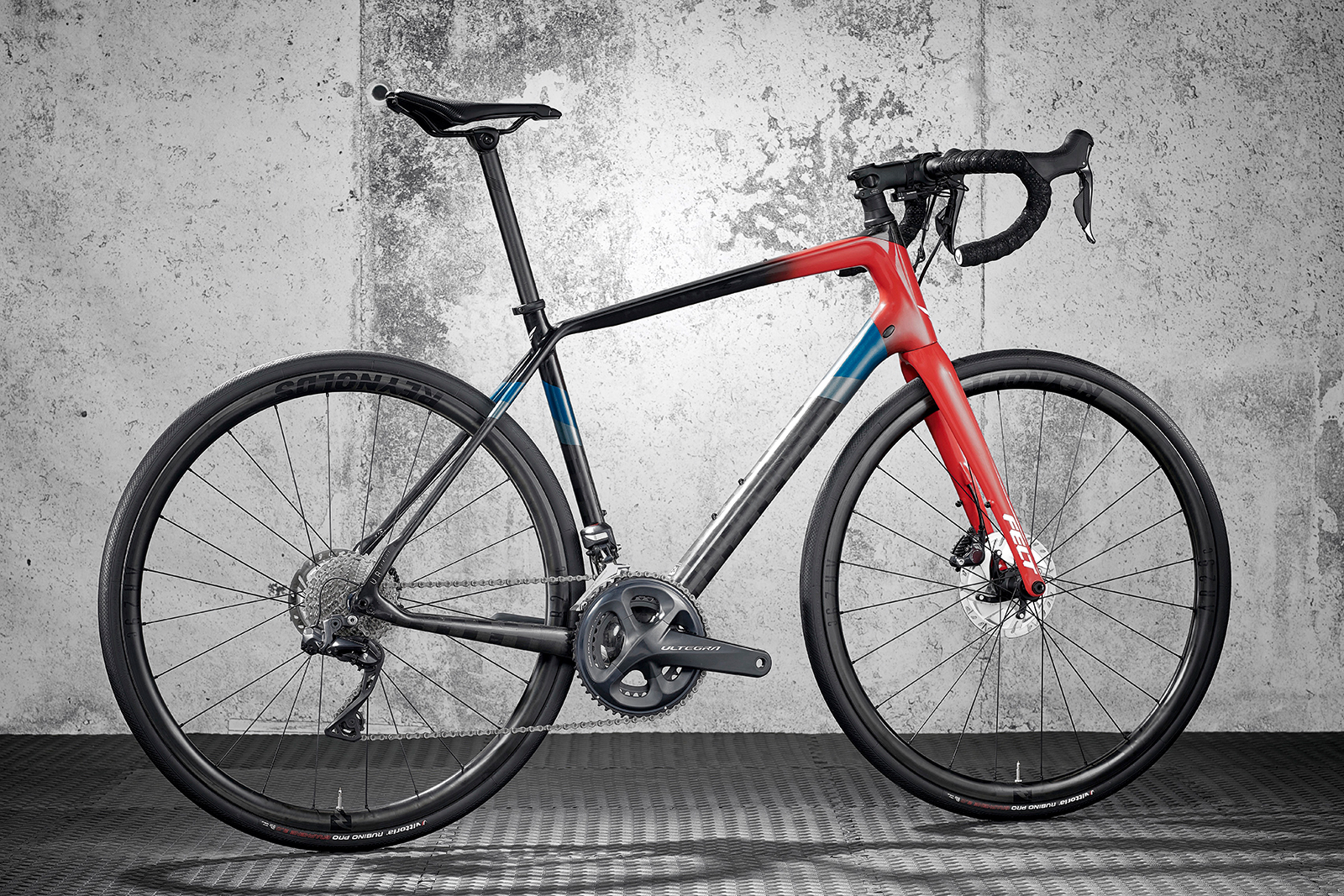
- £4,819 / $6,499 / €5,599 as tested
- Pros: Smooth ride and comfortable position; groupset performance; carbon fibre wheels
- Cons: Cable routing up-front is rather scruffy
The Felt VR range is designed around comfort and distance, with the VR (Variable Road) acronym denoting an ability to go up and down, and conquer bad road surfaces.
It’s clear this bike is geared towards comfort from its silhouette alone, with a long stack and short reach. What you can’t see is that the frame is also geared towards a smooth ride. Different carbon fibres ensure the frame is compliant in the seatstays to absorb road buzz, and stiff in the bottom bracket to aid power transfer.
Pair this frame with the Ultegra Di2 groupset and carbon wheels, and you’ve got a bike that will float over the road and has been specced wisely.
The only niggle we had is the internal cabling isn’t quite as optimised as we’d like. But this isn’t detrimental to the ride.
Look 765 Optimum SRAM Rival eTap AXS

- £4,690 / $5,500 / €4,690 as tested
- Pros: Excellent descending manners; attention to detail; forward-thinking geometry; clean-looking
- Cons: Many components could do with upgrading to unlock bike's potential
Look's 765 Optimum is quite unlike its rivals, with unique seatstays that are flattened but kink inwards as they clear the top of the rear tyre. The bike has clearance for 34mm tyres and there are mudguard mounts. The geometry differs too, with a slightly longer reach than the competition and a slack 70.8-degree head tube angle.
Our tester was impressed by the Look's descending performance, where that slack head angle assists in making the bike easier to handle. On the flipside, it's a little lethargic heading uphill, but the heavy stock wheels bear upgrading to unlock the bike's potential.
The 765 Optimum holds its speed on the flats and is more than up to the job on higher-paced rides, and we appreciated the wide-range gearing of the 10-36t cassette.
In addition to the wheels, the rest of the finishing kit is all own-branded and aluminium, and also warrants upgrading. We'd also suggest the Campagnolo Chorus build is the way to go, which is £1,000 cheaper for largely the same spec.
Our tester spent a year on the bike and upgraded it as he went along, which you can read about in our long-term review.
Ribble CGR Ti Enthusiast

- £4,489 / $4,804 / €4,335 / AU$7,695 as tested
- Pros: Highly comfortable; multi-surface capable; mount of mounts
- Cons: Heavy than comparable options at this price point
The Ribble CGR Ti Enthusiast is designed for cyclocross and gravel as well as road, but that doesn't diminish its performance on tarmac.
On long rides over poor surfaces, the CGR is at home due to its wide tyre clearance, easy gearing and multiple mounts for luggage and mudguards.
A quality spec, which you can customise to your heart's content, combines with a luxurious titanium frame. But you'll have to look elsewhere for a lightweight speedster.
Ribble Endurance SL

- £2,419 as tested
- Pros: Aero tube profiles and cockpit option; groupset performance; bike builder lets you choose your preferred upgrades
- Cons: Rim brakes limit tyre width and don't perform as well in wet weather
Ribble says it has decreased drag by 28 per cent from the previous version of the Endurance SL, with truncated aerofoil profiles, while the optional one-piece carbon aero cockpit routes the cables internally for extra slipperiness.
Our up-spec added £420 to the Ribble’s £2,000 price tag. But even without, it’s an impressive package. You get an Ultegra groupset, although it has rim brakes rather than using discs, and the 11-28t cassette we chose reduced low-end options over a wider-range cassette.
Specialized Allez Sport

- £1,600 / $1,800 / €1,750 / AU$2,500 as tested
- Pros: Quality frame for the money; accessory mounts; wide tyre clearance
- Cons: Uninspiring wheelset and tyres
The Specialized Allez Sport is a versatile endurance road bike that will appeal to a range of riders.
Its geometry shouldn't feel too aggressive to newer cyclists nor too upright for more experienced roadies who like a racy position.
Commuters and year-round cyclists will appreciate the mudguard and rear rack mounts. Plus, the switch to disc brakes makes room for 35mm tyres.
The stock tyres and wheels are mediocre though which takes the shine off an otherwise respectable build.
Trek Domane SLR 7 P1 (Gen 4)

- £9,500 / $9,700 / AU$13,200 as tested
- Pros: Sumptuous ride; lighter, simpler IsoSpeed
- Cons: Questionable value
Trek has excised front IsoSpeed from the fourth-generation Domane. Thanks in part to voluminous 32c tubeless tyres, Trek’s cobble-cruising endurance bike remains as comfortable as ever.
The new, lighter Domane speeds over tarmac and is capable enough off-road to be considered an all-road bike.
However, some of the Domane’s far cheaper rivals are better equipped. On a bike this expensive, its SRAM Force eTap AXS groupset is underwhelming.
Trek Domane SL6 eTap (Gen 3)

- £4,300 / $5,000 / €4,700 as tested
- Pros: Front and rear IsoSpeed decouplers to improve comfort; super-wide clearance for 38mm tyres; down tube storage
- Cons: Heavier than rivals
This third-generation Trek Domane endurance bike, which Trek still sells alongside its Gen 4 bike above, comes with aero features and massive tyre clearance. You can fit 38mm rubber in the frame, which includes Trek’s front and rear IsoSpeed decouplers for increased ride compliance on bumpy surfaces.
You still get mudguard mounts and a compartment in the down tube with a tool wrap to store your tools and a tube. We reckon it’s a great bike for longer rides on less-than-perfect roads.
Spec-wise, this SL6 eTap comes with SRAM Rival eTap AXS 12-speed shifting with 46/33 x 10-36t ratios for both fast riding and super-steep hill climbing. Wheels are wide Bontrager Paradigm 25 with 32mm Bontrager R3 tyres.
We’ve also reviewed the next-spec-up Domane SL7, which comes with Ultegra Di2 and Aeolus Pro aero carbon wheels for £4,900 (as tested), the next down (non-eTap) Domane SL6 with 11-speed Shimano Ultegra and the £2,450 (as tested), 105-equipped Domane SL5, for a comprehensive spread of Domane specs.
Willier Granturismo SLR Ultegra Di2
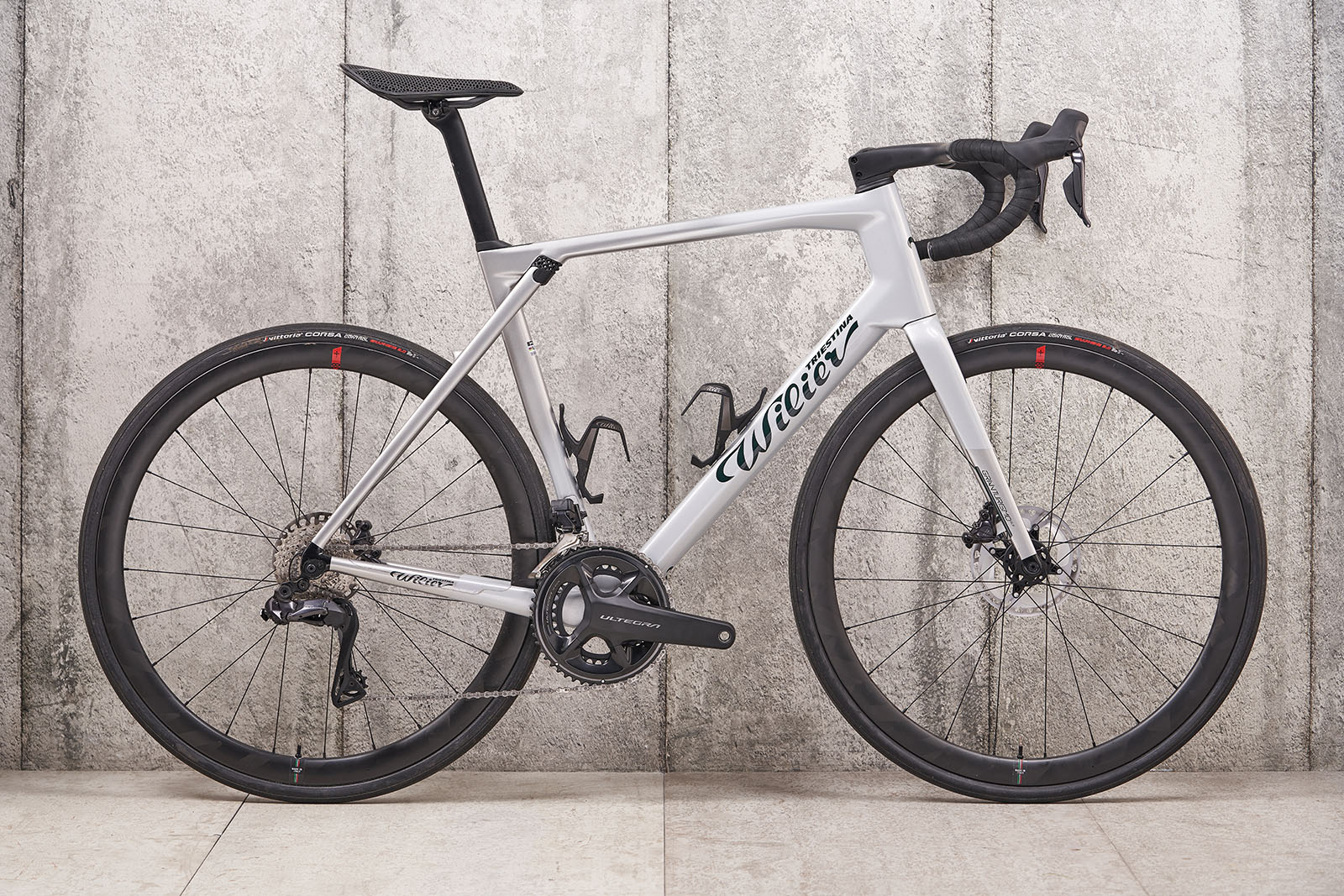
- £8,620 / $9,700 / €8,400 as tested
- Pros: Pacey; poised handling; smooth ride
- Cons: Unbalanced compliance and no mudguard mounts
The Wilier Granturismo SLR Ultegra Di2 swerves away from the endurance bike trend for wide tyre clearance, frame-integrated suspension and progressive geometry.
Instead, you get a nigh-on racier riding position, aero-optimised tube shapes and stiffer frame.
While the spec, including the fabulous Shimano Ultegra R8170 Di2 groupset and Vittoria Corsa Control tyres, is high-end, it doesn't justify the princely price tag.
Buyer’s guide to endurance road bikes: what to look for
What is the difference between an endurance road bike and a race bike?

An endurance road bike will be designed to enable you to cover the distance in comfort.
That means the ride position will be a bit more upright than a typical race bike, favouring ride comfort over ultimate aerodynamics.
The frame may also be designed with additional focus on compliance – or even micro-suspension. They’re intended to take away some of the fatigue induced by road imperfections on an all-day ride.
Endurance road bikes tend to have wider tyres than race bikes, to aid comfort and help create a smoother ride.
While the latest race bikes are generally limited to a maximum tyre size of 28 to 32mm (though this is much wider than just a few years ago, thanks to the rise of disc brakes), some of the latest endurance road bikes have room for 35mm or wider tyres – which is wider than the tyres on cyclocross bikes and not far off some of the best gravel bikes.
Endurance road bikes also tend to have a lower gear range than race bikes. Compact 50/34t chainsets and cassettes with 32-tooth sprockets are not uncommon and some bikes will even have a sub-compact chainset, which will help you crest steep ascents at the end of a long day.
Greater versatility is built into endurance road bikes, too. Race bikes might forgo features such as mudguard mounts, but endurance road bikes tend to have these and are consequently better for riding all-year round.
Frame details
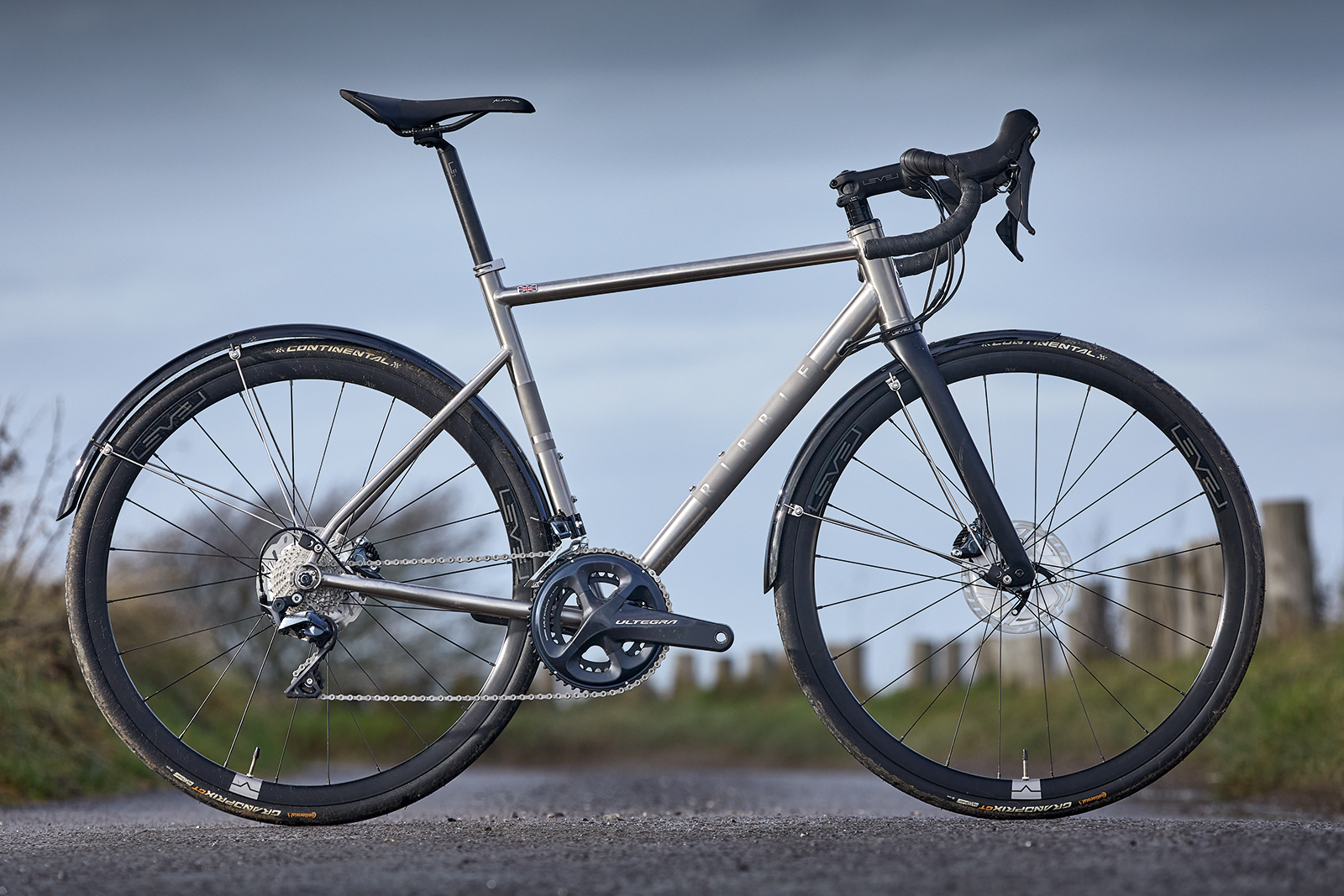
Endurance road bikes are made with a range of different frame materials. Most of the bikes in this list have an all-carbon frame, which helps create a lightweight and compliant ride. Having said this, alloy frames can be designed to be very compliant and tend to offer a price saving.
Many of the best steel road bikes and best titanium road bikes fall into the endurance road bike category, too. These materials tend to be favoured for comfort-orientated, long-distance bikes because they both do a great job of absorbing any road buzz.
You might want to look for an endurance road bike with mudguard mounts. They used to be a rarity, but you’ll increasingly find them even on top-end endurance machines and they’re often hidden so they don’t spoil the bike’s aesthetics if you decide not to fit guards.
If you’re lucky to go out on dry roads, you may not need them. But if the heavens open on the day of your ride, you will enjoy it much more if your bike is fitted with mudguards and you and your bike are protected from wheel spray. And if you’re riding in a group, those following you will definitely thank you.
Mudguards are also a good bet through winter if you live somewhere with a wet climate, making an endurance road bike a good choice for a four-seasons machine.
The best mudguards normally require mounts on the frame to provide full coverage, so look out for a frame with the appropriate mounting points if that’s important to you.
What is endurance road bike geometry?

Many bike brands will label their bikes as having either racing or endurance geometry.
Racing geometry will typically give you faster handling, a lower position and the ride may be firmer, whereas endurance geometry gives a more upright riding position and more stable handling.
All our picks above are from the brands’ endurance road bike ranges. You can also read our explainer on road bike geometry to better understand the angles and measurements involved.
Are endurance road bikes slow?

On the face of it, endurance road bikes might seem like a slower option if you compare them to WorldTour-ready lightweight race bikes or the fastest aero road bikes.
Firstly, this is because the more upright position of endurance road bikes means you are less aerodynamic than on more aggressive road bikes, and consequently it takes more effort to travel at the same speeds.
And while wider tyres can often be faster than old-school narrow tyres, there may be an aero, rolling resistance or weight penalty here, too, if your endurance road bike is using all of its generous frame clearance.
Having said this, endurance road bikes, like all bikes, exist on a spectrum and there are some that have racier geometries than others. On top of that, the latest endurance road bikes occupy a finely balanced sweet spot between speed and comfort.
Many still enable you to adopt a fairly low position, so don’t worry too much about your average speed. Almost all will feel markedly quicker than a gravel bike or touring bike.
And remember, endurance bikes place a greater focus on comfort. So whether that enables you to ride further, or gives you the option for light off-road detours, you’ll ultimately end up at your destination quicker than a race bike with an uncomfortable position and limited versatility.
Endurance road bike gearing

Endurance bikes are designed to meet the challenge of long rides over up and down terrain, enabling riders to tackle it in relative comfort, rather than being forced to turn a massive gear.
If you're going to take on sportives, these are designed to give you a bit of a challenge and much of the ride is often on rolling terrain. Most sportives will throw in a few steeper hills, while some routes take you up and down as much elevation as possible. That means having a good gear range is paramount.
A compact chainset with 50- and 34-tooth chainrings is a good starting point for any endurance bike.
At the back, you’ll normally get a cassette that goes from 11 teeth for its smallest sprocket (or 10 teeth for SRAM’s eTap AXS 12-speed groupsets) up to 30, 34 or more teeth for its largest.
That should give you plenty of low range to tackle steeper uphills, with lowest ratios close to or below 1:1. You’ll also have enough top-end gears to ride comfortably on faster, flatter sections.
Some brands may spec a semi-compact 52/36t chainset on their endurance bikes. These give you a bit more top-end gearing, but paired with a wide-range cassette you still have the lower gears for easier climbing.
However, if you’re relatively new to cycling, live in a hilly area or are planning on taking your bike to the mountains, a compact will give you more gearing options for climbing.
Groupset
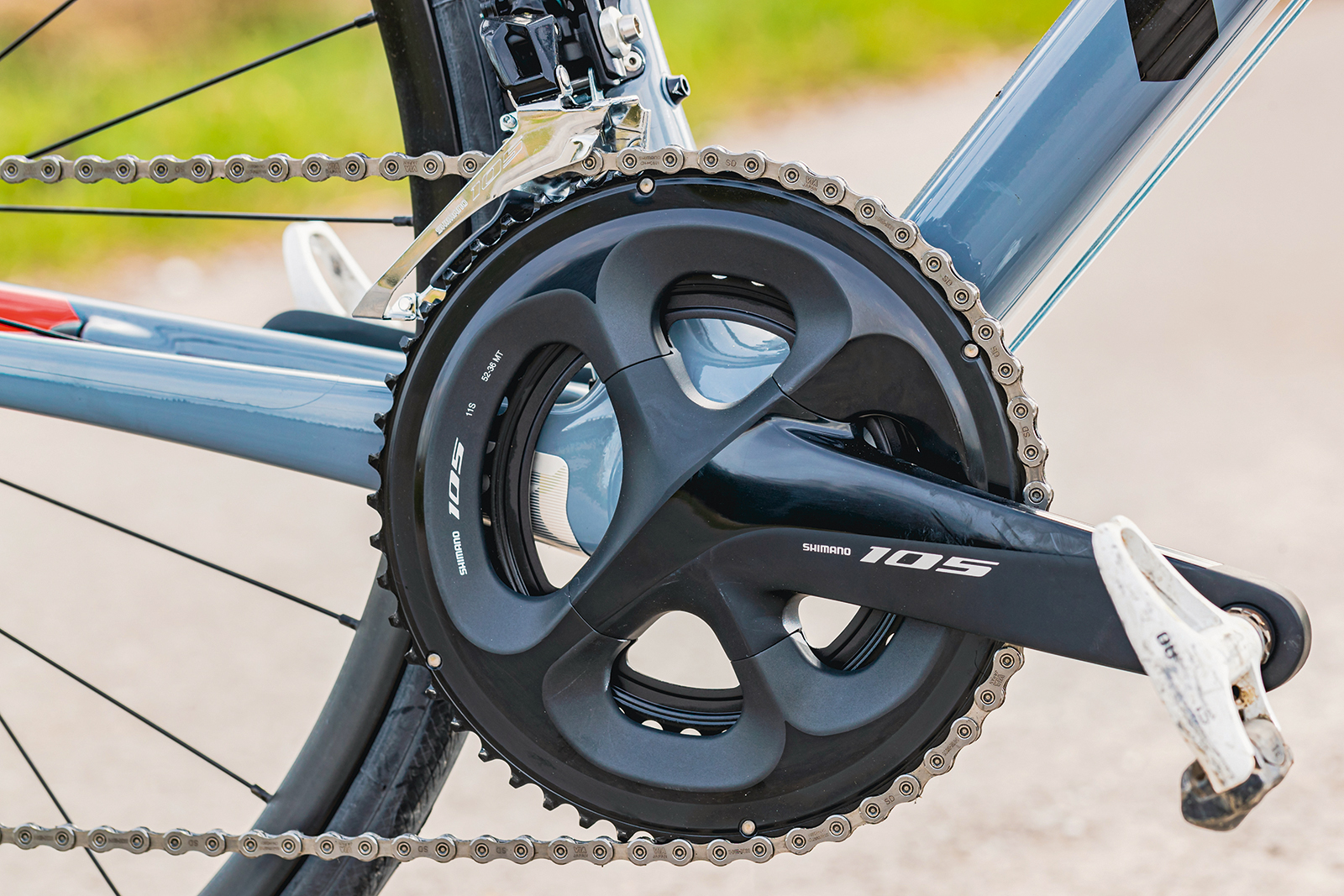
A quality road bike groupset will give you light, precise shifting, with a broad range of gears for a wide variety of terrain.
Most endurance bikes come with 11-speed or 12-speed groupsets. Shimano groupsets are most common, with Ultegra or 105 seen on mid-range bikes, though don't discount Shimano Tiagra on bikes around £1,000 – the 10-speed groupset still provides excellent shifting and braking.
Higher-end bikes are increasingly coming with 12-speed electronic groupsets. 105 Di2 is the starting point for Shimano, but on a top-end machine look for Shimano Ultegra or Dura-Ace.
All have recently been updated, with Shimano 105 Di2, Shimano Ultegra R8100 and Shimano Dura-Ace Di2 R9200 now being 12-speed and electronic only.
Campagnolo and SRAM also have 12-speed electronic options, with SRAM Red eTap AXS, SRAM Force eTap AXS and SRAM Rival eTap AXS offering wireless shifting. Both brands also offer more affordable mechanical groupsets.
Brakes

Modern bikes are almost entirely equipped with disc brakes.
Disc brakes will give you more consistent braking performance, in the wet or dry, than rim brakes and usually more outright stopping power or modulation.
They’re a pricier option than traditional rim brakes, although you can now find discs even on entry-level road bikes.
Disc brakes can be either hydraulic or mechanical. Hydraulic disc brakes are more effective, but they’re also pricier, so you’ll find them on higher-spec machines.
Rim brakes are fine in drier weather, but you need to be more careful how you ride if it’s wet (and especially if your bike has carbon rims), allowing for more stopping distance.
Saddle

You’ll want to be comfortable as you ride and a good-quality saddle that suits your anatomy is important. There’s a huge range of options. Many endurance-oriented bikes will come fitted with a quality saddle, which you might find perfectly serviceable.
However, if you find that you don’t get on with your saddle, it’s worth swapping out for another model. Aftermarket saddles come at a range of price points and most saddle ranges will have a budget option. It will be heavier than a pricier saddle further up the range, but should have similar ride characteristics. More expensive saddles typically come with carbon rails to drop the weight.
Saddle brands usually have a fitting system to narrow down your choice, so it’s worth trying these. For some, you’ll need to find a dealer, while for others you can input your details online and get a selection of models to choose from.
Some brands will offer the option to try before you buy or return a saddle after you’ve used it a little, if you don’t get on with it. It’s worth trying some options rather than suffering in silence.
Tyres

It used to be that most bikes came with 23mm-wide tyres, but most newer road bikes will come with at least 25mm – and even this is considered narrow by today’s standards.
The trend now is for even wider tyres of 28mm or more, and our endurance road bike picks come with rubber that's 32mm or even wider in some cases.
The extra width means that you can drop the tyre pressure on your road bike without sacrificing speed and add a lot more comfort and grip to your ride.
Many of the best road wheelsets also offer the option to run tubeless tyres. The best tubeless tyres let you lower your tyre pressure even more, add puncture protection by removing the need for an inner tube and may save a bit of weight too.